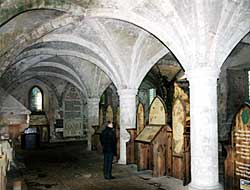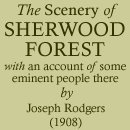< Previous | Contents | Next >
 The undercroft, Rufford Abbey.
The undercroft, Rufford Abbey."Yt was delt in sodenly," says Shrewsbury, in an exculpatory letter to the Queen, "and wythout my knowledge : but as I dare undertake and insure to your Majestic, for my wyfe she fyndinge hyr dawghter dysapointed of young Barte', where she hoped; and that thoder young gentylman was inclined to love with a few days' acquaintance, dyd hyr best to further her dawghter to this match ; without having therein any other intent or respect than wyth reverent duty towards your Majestic she ought."
In a letter to Burghley, the Earl says: "There is few Nobillmen's sons in England that she hath not praid me to dele foire at one tyme or other, so dyd I for my Lord Rutland, wyth my Lord Sussex, for my Lord Wharton, and sondry others ; and now thys comes unloked for wythout thankes to me."
Elizabeth was much displeased. The two Countesses were for a time placed under restraint. But her displeasure was the most severely visited on the young couple, who were neither of them twenty.1
The only issue of the marriage was one daughter, the Lady Arabella Stuart, who was born at Chatsworth, and she being left an orphan at four years of age, was brought up in charge of her grandmother, the Countess of Shrewsbury. The Lady Arabella stood in the same degree of relationship to Elizabeth as did James I., and she is said to have first become an object of public attention in 1603, when her name was brought forward in an alleged plot in which Sir Walter Raleigh, Sir Griffin Markham, of Ollerton, and others were charged with conspiring to raise the Lady Arabella to the throne in place of James. Of any complicity in this scheme, however, the Lady Arabella was acknowledged to be innocent.
Soon after the death of the Countess of Shrewsbury, the Lady Arabella made a progress in the north, when, as Hunter says, "No doubt she would visit in the church at Sheffield the grave of her mother, whose misfortunes she inherited.2 Among other places she also took on her journey Chatsworth, Worksop Manor, and Rufford, to which latter place the following notes in her steward's account have reference:—
"25th. Given among certen poore at Edelstoe (Edwinstowe) as my Lady came with my La. of Shrewsbury to Rugford, 53.
"Sep. 26th. Given among Mrs. Markham's servants at Roughford the night my La. lay there. 5-0-0.
"From Rufford she went next day to Wingfield, and thence to Derby, where the Countess, her grandmother, is buried ; and forward to London."—Longleat Papers.
As her letters bear witness, the Lady Arabella was far from being an ordinary woman, but with the remainder of her troubled career Rufford had little connection.3
Through the marriage of Lady Mary Talbot, daughter of George, sixth Earl of Shrewsbury, with Sir George Savile of Thornhill, the Rufford estates, with Brierly Manor in Yorkshire, passed to the Savile family on the death of her brothers without male issue, under the settlement made by the sixth Earl. Sir George was created a baronet in 1611, and was succeeded by his grandson, also named George, whose father had married at Wentworth a sister of the great Earl of Strafford, and died during the life of the first baronet. The second baronet dying unmarried, and a minor, while at college, was succeeded by his brother, Sir William, who during the Civil War was a staunch partisan of Charles I. He married Anne, daughter of the Lord Keeper Coventry, and was appointed to the charge of Sheffield Castle, "the Hall of his accestors "4; and afterwards to a further command at York. His wife, who was renowned for her courageous conduct during the siege of the castle, was mother of Sir George Savile, the fourth baronet, who afterwards married Dorothy, daughter of Henry Spencer, first Earl of Sunderland, by his wife, the famous " Sacharissa." He was settled at Rufford in 1656.
About this time it came to the knowledge of Cromwell that meetings of the disaffected were being held in various parts of the country, and more particularly at Rufford. Speaking in Parliament on the 17th of September, 1656, he said : " I doubt whether it be believed there ever was any rising in North Wales; at the same time at Shrewsbury; at Rufford Abbey, where were five hundred horse ; or at Marston Moore; or in Northumberland, where all these insurrections were at the very time."
It was probably the gathering of Royalists at Rufford, named above, to which reference is made in a letter to the Protector given in Mr. Robert White's Dukery Records.
"May it please your Highness,—Upon the first notice that I had from Grantham of the meeting at Rufford, I sent notice of it to Col. Hacker : the Major General's horse at Doncaster; and the high Sheriffe of Yorkshire ; and thereupon divers p'ties were sent to examine the truth of it; but we coulde learne nothinge; but upon the receit of yor highnes letter and information, we acted more successfully, and march'd that night towards the place, where Capt. Needham with two troopes of Coll. Hacker's Regiment coming first, made a good entrance into the busines, and seized divers gent', a list whereof you will see here; . . . We expect Coll. Hacker here p'sently, and we shall use our utmost endeavour to p'fect this search. . . . Sir George Savile is not at home. We have detained one Mr. Coventry, who is the Lady Savill's brother, untill Sir George shall appear to yr highness. He is said to be in London at his house in Lincolns in field, at the corner of queens streete, called Carlisle House or Savill House. We can find nothing in his house, that gives any light, onely we heare that one of his family, Mr. Davison, who is Tutor to Sir George, was at the meeting, and stayed in the house till after dinner on fryday, and then went away.
Wee cannot yett get him. . . . Tomson of Newark is at London, but expected home suddenly. We hope ere this goe away to give you an account of the pistolls. A party is gone to the place where they were left. The Carter hath at last confessed somewhat fully, and we have p'missed to befriend him ; being a poor fellow . . ."5
Sir George represented Pontefract in Parliament in 1660; the year of the restoration, at the suggestion of Sir William Coventry, the Duke of York urged Charles II. to elevate Savile to the peerage ; this the King refused to do, although some years afterwards, being anxious to conciliate Savile, he gave him the titles of Baron Savile of Eland and Viscount Halifax.
He was admitted a member of the Privy Council, and dispatched on a mission to the Court of Louis XIV. In Parliament he was a clever and incisive speaker, and for that reason was disliked by the King. On Sir William Temple mentioning Savile's name as one suitable for the new council of thirty, Charles refused to make the appointment; but afterwards withdrew his objection, and ere long Savile became a great favourite at Whitehall.
< Previous | Contents | Next >
1 Leader's Mary Queen of Scots in Captivity;
Hunter's Hallamshire.
2 The following letter from the Earl of Shrewsbury
has reference to this visit: " Harry Duller ... tell Moorhouse my Lady Arabella will
be at Sheffield some day this week, as I verily thinke. Fyshe ynough
must be watered for there will be an extreme great number in the hall
every day. Fatte beefe and fatte muttons must be had, and the beefe in
tyme killed and powdered. Fatt capons provided and preserved till then,
and everything else that either Richard or Moorhouse can provide or thinke
useful: and Wingfield best advice to be had and followed."—Hunter's
Hallamshire.
3 Although the construction is rude, these verses
are not devoid of pathos :—
"Where London's Tower its turrets show
So stately by the Thames's side.
Fair Arabella, child of woe,
For many
a day had sat and sighed.
And as she heard the waves arise,
And as she heard the bleake winds roar,
As fast did heave her heartfelt sighs,
And still so fast her tears did
poure."
—Old ballad of Arabella Stuart, supposed to be
written by Mickle, quoted in D'Israeli's Curiosities of Literature.
4 Many letters of Sir William's are found in Hunter's
Hallamshire, principally on matters connected with the war. He writes
from York desiring to be informed "how
Cuthbert hath found the Hopyard at Rufford," which he says " the
sooner it is gathered the more for the profit."
In the articles for the surrender of the Castle
at Sheffield, it is stipulated that " the Lady Savile, and her children
and family, with her own proper goods, shall and may pass with coaches,
horses and wagons, to Thornhill,
or elsewhere, with a sufficient guard befitting her quality, and without
injury to any of their persons, or plundering any of their goods, or otherwise.
She, they, or any of them to go, or stay at their own pleasure, until she,
or they, be in a condition to remove themselves."
5 These Royalists are said to have had a cartload of
arms ready to distribute to their friends, but on the discovery of their
designs they were left in the open fields.—White's Worksop and the Dukery.
